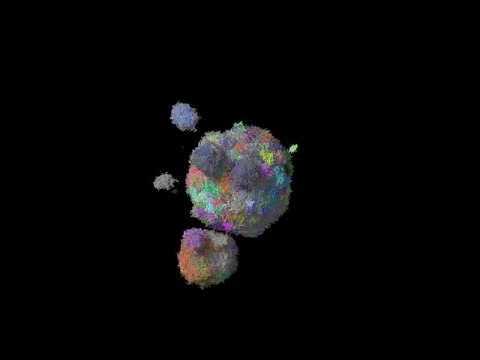Could Charles Darwin help us to fight cancer? The answer is an emphatic yes according to an Anglo-American team which today unveils eerily beautiful videos that model the evolution of a tumour in three dimensions.

In one set of computer simulations, a rogue cell blooms into a kaleidoscope of cell types, then melts away when treated with a cancer drug, only to blossom once again with renewed vigour into deadly and malignant masses of billions of cells.
Cancer is marked by a breakdown of cooperation between cells in the body, when one of the body’s 200 or so cell types develops mutations – changes in their DNA – that put the cell’s own interests above the greater good of the body.
By shrugging off the controls that keep the rest of our body in check, tumour cells divide willy-nilly, picking up new genetic changes along the way so they can evolve to resist drugs, or grow faster, for example. As a result, even a single tumour can contain utterly different genetic mutations in the cells at one end, compared with cells at the other.
But because cancer cells are distorted versions of normal cells in the body, they are hard to target and destroy without causing damaging side effects. Because cancer is marked by its rapid growth doctors have, for example, used drugs that are toxic to all dividing cells in the body, causing side effects such as hair loss, nausea and so on.
Recent years have seen the development of drugs that target cancer cells with specific mutations. These drugs shrink tumours during the first months of treatment but the cancer cells often become resistant as new mutations help to outwit the drugs, and the disease returns.
Now the collaboration between Harvard, Edinburgh, and Johns Hopkins Universities has come up with a mathematical portrait of the evolution of solid tumours of the kind found in the breast, ovary or colon.
The new work, published today in the journal Nature, is a joint project by a team that includes Bartek Waclaw a physicist and computer wizard at Edinburgh, the distinguished cancer researcher Bert Vogelstein of Johns Hopkins, and Martin Nowak, Director of Harvard’s Program for Evolutionary Dynamics, who has spent decades trying to put biology on a mathematical basis, along with his colleague in Harvard University, Ivana Bozic.
Although biologists traditionally complain that disease processes are too complex to boil down to mathematics, Nowak believes the new model can explain various features of cancer, from why cancer cells share a surprising number of mutations in common, to why tumours spread and become resistant to anti-cancer drugs.
The new mathematical model captures the complex way that DNA mutates in different tumour cells, which makes some cells more suited to the environment than others, and how cancer spreads. Until now, these have been modelled separately. “Most previous efforts counted the number of cells with particular DNA changes but not their spatial arrangement,” says Nowak. “Now we can model both the genetic evolution and the 3D growth of a cancer.”
One of the new insights to emerge is that cancer growth depends greatly on the ability of tumour cells to cells to divide if they have sufficient space. This means the tumour grows slowly unless cells are able to move to find enough room. “Cellular mobility makes cancers grow fast, and it makes cancers similar in the sense that cancer cells share a common set of mutations,” says Nowak. That, he thinks, is why drug resistance rapidly evolves.
In the video, similar colours denote similar mutations and – as the tumour grows – they remain clustered together, as also shown by experiment. Of the billions of cancer cells that exist in a patient, only a tiny percentage – about one in a million – are resistant to drugs used in targeted therapy. When treatment starts, the video shows how non-resistant cells are wiped out – but the few resistant cells quickly repopulate the cancer.
There is another insight to emerge from focusing on cell movements within the tumour: they go on to evolve the ability to spread throughout the body, to metastasize, which is usually what makes cancer deadly. Nowak says: “The ability to form metastases is a consequence of selection for local migration, that is Darwinian processes favour cells with the ability to move around the body.”
These insights, which are a ‘beautiful confirmation of what is seen in experiments,’ do not provide a ‘miraculous cure,’ said Bartek Waclaw, “However, they do suggest possible ways of improving cancer therapy.” The video shows how cancer cells switch to a state when they can deform and move around and, he says, treatments that hinder these small movements of cancerous cells could help to slow progress of the disease.
The attempts through history to understand and combat diseases such as cancer can be found in the Science Museum’s medicine collections, which contain over 140,000 objects. The museum is now developing major new Medicine Galleries to showcase thousands of objects with initial leadership funding from the Wellcome Trust, the Heritage Lottery Fund and the Wolfson Foundation.
The galleries will open in 2019, transforming much of the first floor of the Museum. In preparation, Glimpses of Medical History and The Science and Art of Medicine will close on 20th September. However, you will still be able to see highlights from the collection in a new exhibition, Journeys Through Medicine: Henry Wellcome’s Legacy, opening on Thursday 1st October. Further items can also be seen at the Wellcome Collection and explored online via our Brought to Life: exploring the history of medicine. These collections are of enduring interest because medicine is where science collides with life.
By Roger Highfield, Director of External Affairs and coauthor with Martin Nowak of SuperCooperators, Beyond the Survival of the Fittest: why Cooperation, Not Competition, is the Key of Life